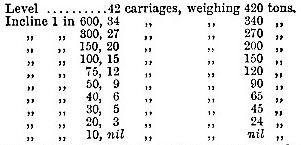1902 Encyclopedia > Railway, Railways (Railroad) > Locomotive Power: Speed and Engine Power
Railway, Railways
(Part 30)
F. LOCOMOTIVE POWER
Speed and Engine Power
As the speed increases a more than proportional increase in the engine-power is necessary to draw a given train. Thus, if an engine and tender, weighing together 40 tons and exerting a given tractive force, takes, say, forty loaded carriages, weighing 360 tons, at 20 miles per hour on a level, the loads which it could take if it exerted the same tractive power at higher speeds would be only as follows:—
The influence of gradients also is very important. If an engine and tender, weighing together 40 tons, is capable of drawing a maximum train of, say, forty-two loaded carriages, weighing 420 tons, at 20 miles per hour on a level, it would only draw the following loads at the same speed on the following inclines:—

This is the reason why the older railways were made nearly level at an enormous cost,—the elder Stephenson’s policy being to incur a large expenditure in construction in order to avoid otherwise heavy inclines and heavy expenses. The ruling gradient of the Liverpool and Manchester Railway was fixed at 1 in 900, excepting, of course, the inevitable inclines at Rainhill summit, for working which special provision was made; that of the next great line, the London and Birmingham, was fixed at 1 in 330; on the Great Western Railway, one of the earliest made lines, the ruling inclination is 1 in 1320 for the greater part of the way. Locke, as already explained, initiated the system of cheaply constructed railways, as the facilities for increasing the power of locomotives became better understood; he constructed lines with long steep gradients, some of them 1 in 70, 1 in 75, 1 in 80. The Great Northern Railway, of comparatively recent origin, was constructed on a ruling gradient of 1 in 200; and, in general, the more recently made lines have the steepest gradients. Steep railways are generally also lines of frequent curves, which is another cause of loss of locomotive power. Moreover, the ruling speeds, as they may be called, have in the course of years increased. Thus in every way more powerful engines are now needed than in the early day of railways.
Read the rest of this article:
Railway, Railways - Table of Contents
|

